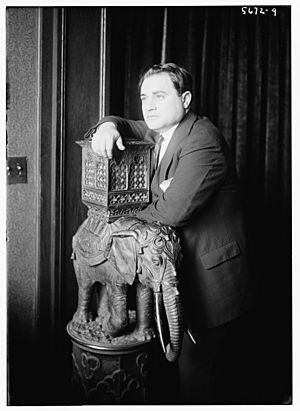Beniamino Gigli facts for kids
Quick facts for kids
Beniamino Gigli
|
|
|---|---|

Beniamino Gigli in an image from 1914
|
|
| Born | 20 March 1890 |
| Died | 30 November 1957 (aged 67) |
| Nationality | Italian |
| Occupation | Singer |
Beniamino Gigli (JEE-lee 20 March 1890 – 30 November 1957) was a famous Italian opera singer. He was known as a tenor, which is a type of male singing voice. Many people think he was one of the best tenors of his time.
Biography
Beniamino Gigli was born in Recanati, Italy, on March 20, 1890. His father was a shoemaker who loved opera. However, his parents did not think music was a safe job.
In 1914, Gigli won first place in a singing competition in Parma. His first time singing in an opera was on October 15, 1914. He played the role of Enzo in La Gioconda in Rovigo. After this, many people wanted him to sing for them.
Gigli quickly made his debut at many important opera houses. He often sang in the opera Mefistofele. He performed at the Teatro Massimo in Palermo in 1915. He also sang at the Teatro di San Carlo in Naples in 1915. In 1916, he sang at the Teatro Costanzi di Roma. He performed at La Scala in Milan in 1918. Then, he went to the Teatro Colón in Buenos Aires in 1919. Finally, he sang at the Metropolitan Opera in New York City in 1920.
Gigli became famous for roles like Edgardo in Lucia di Lammermoor by Gaetano Donizetti. He also sang Rodolfo in La Bohème by Giacomo Puccini. Another famous role was the main character in Andrea Chénier by Umberto Giordano. He later recorded these operas completely.
Gigli became even more famous after the death of another great tenor, Enrico Caruso, in 1921. People often called him "Caruso Secondo" (Caruso the Second). But Gigli preferred to be called "Gigli Primo" (Gigli the First). Caruso had a bigger, darker voice. Gigli's voice was strong but also sweet and clear.
Gigli left the Metropolitan Opera in 1932. He returned to Italy and sang in many opera houses there. He also performed in other parts of Europe and South America. During World War II, it was hard for him to perform. But after the war ended in 1945, he returned to the stage. Audiences were very excited to see him.
Besides singing on stage, Gigli also acted in over twenty films. He made movies from 1935 to 1953. Some of his notable films include Ave Maria (1936) and I Pagliacci (1943).
In his later years, Gigli gave more concerts than stage performances. He went on a long world tour of farewell concerts before he retired in 1955. This tour made him tired, but he used the time to help write his life story. He died in Rome in 1957.
Personal life
Beniamino Gigli was a very generous person. He gave many concerts to raise money for good causes. He raised more money than almost any other singer. He was also very devoted to his spiritual advisor, Padre Pio. Gigli often sang sacred music, which is music for religious purposes.
Gigli was married to Costanza. They had two children together, a son named Enzo and a daughter named Rina. Rina also became a well-known opera singer.
Vocal style
When Gigli started his career, his voice was known for being beautiful and soft. It was described as "honey-like." He could sing light, gentle parts very well. As he got older, his voice became stronger. This allowed him to sing more dramatic roles. Some people said he showed a lot of emotion when he sang.
Legacy
Many of Gigli's recordings are still available today. These include full operas with singers like Maria Caniglia and Licia Albanese. His recordings go back to the 1920s. You can find them reissued on CDs.
Selected filmography
- Forget Me Not (1935)
- Forget Me Not (1936)
- Ave Maria (1936)
- The Voice of the Heart (1937)
- Mother Song (1937)
- Night Taxi (1950)
See also
 In Spanish: Beniamino Gigli para niños
In Spanish: Beniamino Gigli para niños


